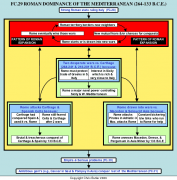FC29: The Roman conquest of the Mediterranean (264-133 BCE)
Flowchart
Just as Rome got caught up in a cycle of expansion that led to the conquest of Italy, it experienced another such cycle that led to their dominance of the Mediterranean. In this case, what triggered the pattern was the mere fact that each new conquest brought Rome into contact with a new set of neighbors. This would lead to new opportunities for conquest, but also mutual fears and suspicions on each side. Either way, Rome would get drawn into a new set of wars, which it would eventually win with new conquests. This, of course, would present Rome with some more new neighbors and the pattern would repeat itself until Rome had conquered the Mediterranean.
The first phase of this expansion involved Rome in two desperate wars against Carthage (264-241 & 218-201 B.C.E.). Initially, this struggle was over Sicily, since it was rich, very close to Italy, and Rome had to protect the trade of its Greek subjects in Southern Italy against Carthaginian encroachment. Rome's victory in these wars made it a major naval power controlling Sicily and dominating the Western Mediterranean. Feeding back into the cycle of expansion, this also led to contact and conflict with new peoples in the Eastern and Western Mediterranean.
In the West, Rome got involved in wars with Carthage and the Celts in Spain, both of whom Rome feared from previous wars. Therefore, Rome conquered and destroyed Carthage in 146 B.C.E. and the Spanish Celts by 133 B.C.E., both of them in rather brutal and treacherous fashion.
In the East, Rome was more reluctantly drawn into wars against Antigonid Macedon and Seleucid Asia by two main factors. For one thing, Macedon, suspicious of Rome since it had crushed the Illyrian pirates close to Macedon's shores, had declared war on Rome during its darkest days of the Second Punic War. While nothing much came of this First Macedonian War (215-205 B.C.E.), Rome was naturally suspicious of Macedon. Feeding this suspicion was the second factor, various Greek states running to Rome for protection, at first against Macedon and the Seleucids, and later against each other. As Rome was drawn increasingly into affairs in the East, its frustrations grew until it annexed Macedon (149 B.C.E.), Greece (146 B.C.E.) and Pergamum in Asia Minor, which was willed to Rome by its king in 133 B.C.E.
By 133 B.C.E., Rome was the dominant power in the Mediterranean. Unfortunately, having an empire would put stresses and strains on Roman society, including the creation of ambitious generals looking for new opportunities for conquest, plunder, and glory. Therefore, the Roman tide of conquest continued after 133 B.C.E. In the West, an ambitious general named Julius Caesar would push the barbarian threat even further north by conquering the Celts in Gaul. Eventually, the rest of North Africa would fall under Roman rule to round out control of the Western Mediterranean. Meanwhile, in the East, Mithridates of Pontus attacked Rome's provinces in Asia Minor. Rome won both of these Mithridatic wars, and its generals, most notably Pompey, progressively annexed the rest of Asia Minor, Syria, Palestine, and Egypt. Thus by the early Christian era, the entire Mediterranean was firmly under Roman rule.


